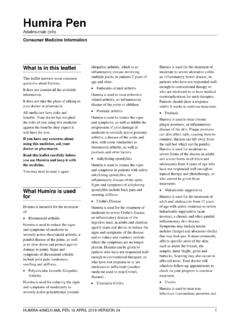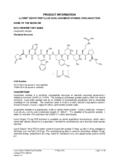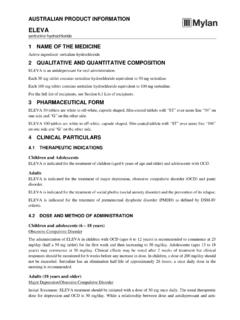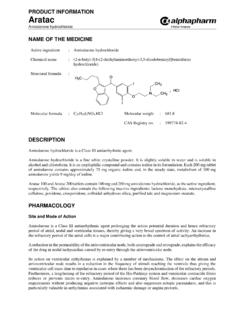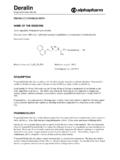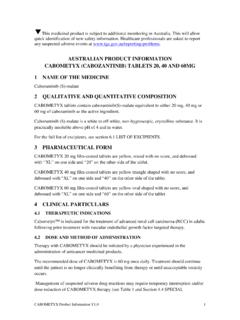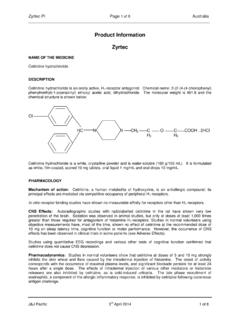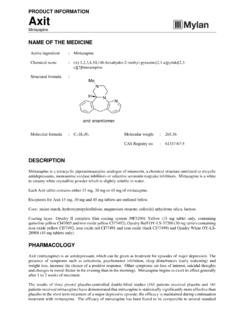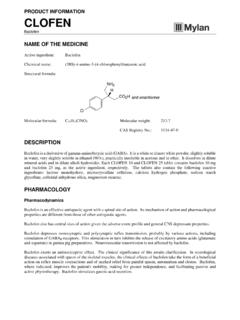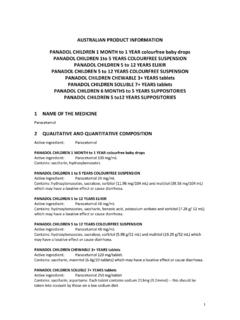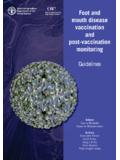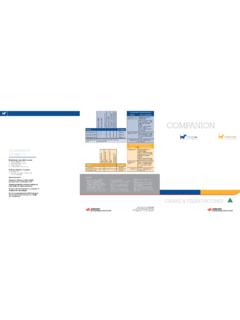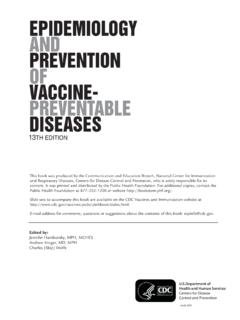Transcription of AUSTRALIAN PRODUCT INFORMATION ACT-HIB …
1 AUSTRALIAN PRODUCT INFORMATION . ACT-HIB HAEMOPHILUS TYPE B CONJUGATE VACCINE. (CONJUGATED TO TETANUS PROTEIN). 1 NAME OF THE MEDICINE. ACT-HIB Haemophilus Type b Conjugate Vaccine (conjugated to tetanus protein). Haemophilus Type b polysaccharide 2 QUALITATIVE AND QUANTITATIVE COMPOSITION. ACT-HIB contains the capsular polysaccharide of the Haemophilus influenzae type b bacterial strain conjugated to tetanus protein. The polysaccharide consists of polyribosyl ribitol phosphate (PRP). Active Ingredients: Haemophilus type b polysaccharide (10 micrograms) conjugated to tetanus protein (18-30 micrograms).
2 For the full list of excipients, see Section List of excipients. 3 PHARMACEUTICAL FORM. ACT-HIB is a freeze-dried powder for reconstitution with diluent for injection. Following reconstitution, the solution is limpid and colourless. 4 CLINICAL PARTICULARS. THERAPEUTIC INDICATIONS. ACT-HIB is indicated for use in infants from 2 months to 5 years of age for active immunization against invasive disease caused by the Haemophilus influenzae type b. The vaccine does not protect against infections due to other types of Haemophilus influenzae nor against meningitis from other origins.
3 NOTE: Under no circumstances should the tetanus protein component of this vaccine be substituted for the routine Tetanus vaccination. DOSAGE AND METHOD OF ADMINISTRATION. After reconstitution, the vaccine should be administered via the intramuscular or subcutaneous route. act-ccdsv8-piv2-05feb19 Page 1 of 8. The preferred injection site for children under 2 years of age is anterolateral thigh. In older children the vaccine may be given at the anterolateral thigh or deltoid region. Vaccine injections should not be given in the dorsogluteal site or upper outer quadrant of the buttock because of the possibility of a suboptimal immune response.
4 For further INFORMATION , refer to the current Immunisation Handbook. Infants: 2-6 months age 3 injections at 1 or 2 month intervals. 7-11 months age 2 injections at 1 or 2 months intervals. This is followed in both cases by a booster at 18 months. In children over 12 months: A single injection. The reconstituted PRODUCT must be used immediately after reconstitution. Once reconstituted, the vaccine must not be mixed with any other vaccine or medicinal PRODUCT . Therefore, separate injection sites and different syringes should be used in case of concomitant administration.
5 ACT-HIB is for single use only and must not be used in more than one individual. Discard any remaining unused contents. ACT-HIB can be incorporated into the recommended childhood immunization schedule, in accordance with the DTP schedule. However, the administration of ACT-HIB should be carried out in a different site from those used for the other recommended vaccinations: Diphtheria, Tetanus, Pertussis, Poliomyelitis and Measles, Mumps and Rubella. CONTRAINDICATIONS. Known systemic hypersensitivity to any component of ACT-HIB in particular the tetanus protein or formaldehyde.
6 Life-threatening reaction after previous administration of the vaccine or vaccine containing the same substances. Vaccination must be postponed in case of febrile or acute disease. SPECIAL WARNINGS AND PRECAUTIONS FOR USE. As with all injectable vaccines, appropriate medical treatment and supervision should always be readily available in case of an anaphylactic event following administration of the vaccine. Do not administer by intravascular injection: ensure that the needle does not penetrate a blood vessel. As with all injectable vaccines, the vaccine must be administered with caution to subjects with thrombocytopenia or a bleeding disorder since bleeding may occur following an intramuscular administration to these subjects.
7 Act-ccdsv8-piv2-05feb19 Page 2 of 8. Prior to administration of any dose of ACT-HIB , the parent or guardian of the recipient must be asked about their personal history, family history, and recent health status, including immunisation history, current health status and any adverse event after previous immunisations. In subjects who have a history of serious or severe reaction within 48 hours of a previous injection with a vaccine containing similar components, the course of the vaccination must be carefully considered. The anticipated antibody response may not be obtained in individuals with impaired immune function due to drugs or disease.
8 Experience with native populations (Alaska, Native American Indians) generally suggests that response to all conjugated Haemophilus influenzae type b vaccines in these populations may be significantly lower than in Caucasians. The possibility of a lower antibody response in the AUSTRALIAN aboriginal population should be borne in mind. As with most vaccines, the expected antibody response may not be achieved in 100% of cases. INFORMATION is currently lacking on the value of vaccinating with ACT-HIB after exposure to infection. Cases of Haemophilus influenzae type b disease may occur in the weeks after vaccination prior development of an adequate antibody response.
9 The potential risk of apnoea and the need for respiratory monitoring for 48-72 h should be considered when administering the primary immunisation series to very premature infants (born 28 weeks of gestation) and particularly for those with a previous history of respiratory immaturity. As the benefit of vaccination is high in this group of infants, vaccination should not be withheld or delayed. INTERACTIONS WITH OTHER MEDICINES AND OTHER FORMS OF. INTERACTIONS. Concurrent administration of ACT-HIB and DTP vaccines results in a somewhat lower antibody response to the diphtheria and pertussis components, although the levels are above those considered to be protective.
10 FERTILITY, PREGNANCY AND LACTATION. Effects on Fertility No data available. Use in Pregnancy (Category B2). Vaccination of adults against Hib is uncommon. Data on the use of this vaccine in pregnant women are limited. Therefore, administration of the vaccine during pregnancy is not recommended. ACT-HIB should be given to pregnant women only if clearly needed and following an assessment of the risks and benefits. act-ccdsv8-piv2-05feb19 Page 3 of 8. Use in Lactation Vaccination of adults against Hib is uncommon. It is not known whether ACT-HIB is secreted in human milk.
